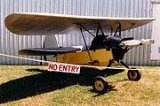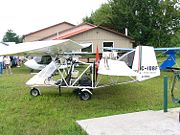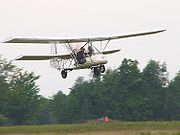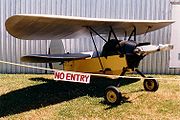
Flying Flea
Encyclopedia
The Flying Flea (Pou du Ciel literally "Louse of the Sky" in French) is a large family of light homebuilt aircraft
Homebuilt aircraft
Also known as amateur-built aircraft or kit planes, homebuilt aircraft are constructed by persons for whom this is not a professional activity. These aircraft may be constructed from "scratch," from plans, or from assembly kits.-Overview:...
first flown in 1933.
Development
The Flying Flea family of aircraft was designed by FrenchmanFrance
The French Republic , The French Republic , The French Republic , (commonly known as France , is a unitary semi-presidential republic in Western Europe with several overseas territories and islands located on other continents and in the Indian, Pacific, and Atlantic oceans. Metropolitan France...
Henri Mignet
Henri Mignet
Henri Mignet, Henri Mignet, Henri Mignet, (October 19, 1893 in Charente-Maritime – August 31, 1965 in Pessac in Gironde, was a French radio engineer who became well-known as an aircraft designer and builder...
.
Between 1920 and 1928, Mignet built various prototypes from the HM.1 to the HM.8, a monoplane
Monoplane
A monoplane is a fixed-wing aircraft with one main set of wing surfaces, in contrast to a biplane or triplane. Since the late 1930s it has been the most common form for a fixed wing aircraft.-Types of monoplane:...
that was the first of his designs that really flew.
Between 1929 and 1933, he continued building prototypes, and testing them in a large field near Soissons
Soissons
Soissons is a commune in the Aisne department in Picardy in northern France, located on the Aisne River, about northeast of Paris. It is one of the most ancient towns of France, and is probably the ancient capital of the Suessiones...
.
HM.14
In 1933, Mignet successfully flew for the first time in his HM.14, the original flying flea, and publicly demonstrated it. In 1934, he published the plans and building instructions in his book Le Sport de l'Air. In 1935, it was translated into English and serialised in Practical MechanicsPractical Mechanics
Practical Mechanics was a monthly British magazine devoted mostly to home mechanics and technology. It was first published by George Newnes, Ltd., in October 1933, and ran for 352 issues until the magazine's termination in August 1963. Practical Mechanics was edited by Frederick J...
, prompting hundreds of people to build their own Flying Fleas.
Mignet's original HM.14 prototype aircraft was powered by a 17 hp Aubier-Dunne 500 cc two stroke motorcycle engine. It had a wingspan of 19.5 feet (5.9 m), a length of 11.5 feet (3.5 m) and a gross weight of 450 lb (204 kg). It had a usable speed range of 25-62 mph (40–100 km/h). In the UK in 1935 and 1936, many aerodynamic and engine developments took place, notably by Stephen Appleby
Stephen Appleby
Stephen Villiers Appleby was an English pilot, and leading proponent of the Mignet Pou-du-Ciel "Flying Flea" aircraft.-Early years:...
, John Carden and L.E. Baynes.
Design
Mignet made the aircraft intentionally simple. The Flying Flea is essentially a highly staggered biplaneBiplane
A biplane is a fixed-wing aircraft with two superimposed main wings. The Wright brothers' Wright Flyer used a biplane design, as did most aircraft in the early years of aviation. While a biplane wing structure has a structural advantage, it produces more drag than a similar monoplane wing...
, which almost could be considered to be a tandem wing
Tandem wing
thumb|right|QAC Quickie Q2A tandem wing aircraft usually involves two full-sized wings, both of which are full airfoils. Sometimes an aircraft of this configuration can look like a variation on the biplane, but is in fact very different. The forward wing is often technically a canard, fitted with...
aircraft, built of wood and fabric. The original design was a single-seater, and had two-axis flying controls. The aircraft had a standard control stick. Fore-and-aft movement controlled the front wing's angle of attack
Angle of attack
Angle of attack is a term used in fluid dynamics to describe the angle between a reference line on a lifting body and the vector representing the relative motion between the lifting body and the fluid through which it is moving...
, increasing and decreasing the lift of the wing. Because the front wing was located forward of the center of gravity
Center of gravity
In physics, a center of gravity of a material body is a point that may be used for a summary description of gravitational interactions. In a uniform gravitational field, the center of mass serves as the center of gravity...
, that would pitch the nose up and down.
Side-to-side movement of the stick controlled the large rudder. This produced a rolling motion because the wings both had substantial dihedral, through yaw-roll coupling. The rudder had to be quite large not only to produce adequate roll but also because the fuselage was very short, reducing the leverage of the rudder. The Flying Flea, being a two axis aircraft, could not be landed or taken off in substantial crosswinds. This was not a big issue when the aircraft was designed because at that time aircraft were usually flown from large open fields allowing all take-offs and landings into wind.
Mignet claimed that anyone who could build a packing case and drive a car could fly a Flying Flea.
Variants


- HM.16 Pou-Bébé (Baby Pou) - 1936, single-seat lightweight Pou, 25 hp Ava engine
- HM.18 - 1937, single-seat, enclosed cockpit, 35 hp Mengin engine. (example: G-AENV).
- HM.19 - 1937, two-seat, enclosed cockpit, 45 hp Salmson engine.
- HM.210 - 1937, single-seat, enclosed cockpit, airworthiness certificated.
- HM.280 Pou-Maquis - 1944, single-seat, folding wings, for French partisans.
- HM.290 - 1945, single-seat, enclosed cockpit. Became popular for amateur construction from plans, with optional enclosed cockpit, various types of engine 25 hp to 70 hp. (example: CF-RFH).
- HM.293 - 1946, single-seat variant for larger pilots, typically powered by 50-60 hp VW engine. (example: G-AXPG).
- HM.310 Estafette - 1952, two-seat, enclosed cockpit, 67 kW (90 hp) Continental A90-12F engine.
- HM.320 - 1955, single-seat, enclosed cockpit. (example: F-PHZI).
- HM.330 Cerisier en Fleurs - 1954, two-seat, enclosed cockpit.
- HM.350 - 1957, two-seat, enclosed cockpit. (example: F-PHQT).
- HM.351 - 1955, two-seat, enclosed cockpit. Also known as Tachikawa R-HM (example: JA3094).
- HM.360 - 1957, single-seat, enclosed cockpit, improved wing geometry. (example: F-PNUO).
- HM.380 - 1957, two-seat, enclosed cockpit, 1100 lb gross weight, typically powered by 60-100 hp engine. (example: F-PKFN).
- HM.390 - 1981, two-seat(?), enclosed cockpit. (example: F-WJDY).
- HM.1000 Balerit - 1986, two-seat, pusher propeller, rear-mounted 64 hp Rotax engine, used by the French Army.
- HM.1100 Cordouan - 1996, two-seat, front-mounted 80 hp Rotax engine.
Safety concerns
In the 1930s, many Fleas crashed when pilots could not recover from shallow dives, resulting in some deaths. As a result, Flying Fleas were grounded and even banned from flight permanently in some countries. In the United Kingdom, restrictions were placed on Flying Fleas, following a fatal crash on 4 May 1936 at an air display at Penshurst AirfieldPenshurst Airfield
Penshurst Airfield was an airfield in operation between 1916–36 and 1940–46. Initially a military airfield, after the First World War it was used as an alternate destination to Croydon Airport, with some civil flying taking place...
, Kent
Kent
Kent is a county in southeast England, and is one of the home counties. It borders East Sussex, Surrey and Greater London and has a defined boundary with Essex in the middle of the Thames Estuary. The ceremonial county boundaries of Kent include the shire county of Kent and the unitary borough of...
.
When on approach to land, the pilot would push the stick forward to gain speed for the flare and landing. As speed built up, the rear wing, operating at a greater angle of attack
Angle of attack
Angle of attack is a term used in fluid dynamics to describe the angle between a reference line on a lifting body and the vector representing the relative motion between the lifting body and the fluid through which it is moving...
would gain lift and pitch the aircraft's nose further downward. The pilot's normal reaction would be to pull back on the stick. This action would increase the angle of attack on the front wing by lowering the trailing edge
Trailing edge
The trailing edge of an aerodynamic surface such as a wing is its rear edge, where the airflow separated by the leading edge rejoins. Essential control surfaces are attached here to redirect the air flow and exert a controlling force by changing its momentum...
of the wing. Because the trailing edge of the front wing was close to the leading edge
Leading edge
The leading edge is the part of the wing that first contacts the air; alternatively it is the foremost edge of an airfoil section. The first is an aerodynamic definition, the second a structural one....
of the rear wing, the front wing's downwash would accelerate the air over the rear wing and cause it to gain lift more quickly that the front wing, resulting in an ever increasing nose pitch-down and flight directly into the ground.
Mignet had not encountered this problem during his testing of his prototype, because he could not afford a large horsepower engine. When builders started putting larger engines on them and expanding the flight envelope, the wing interference problem surfaced.
The Royal Aircraft Establishment
Royal Aircraft Establishment
The Royal Aircraft Establishment , was a British research establishment, known by several different names during its history, that eventually came under the aegis of the UK Ministry of Defence , before finally losing its identity in mergers with other institutions.The first site was at Farnborough...
in the United Kingdom and the French Air Ministry conducted full-scale wind tunnel
Wind tunnel
A wind tunnel is a research tool used in aerodynamic research to study the effects of air moving past solid objects.-Theory of operation:Wind tunnels were first proposed as a means of studying vehicles in free flight...
tests, and discovered the problem. Their investigations resulted in changes to the airfoil used and the spacing of the wings to prevent aerodynamic interference. Later Mignet Flea designs incorporated these changes.
By 1939, there were many improved Flying Fleas in the air, but the aircraft never completely overcame its dangerous reputation.
Amateur construction
Shortly after the plans appeared in 1934, many enthusiasts in Europe and the USA began to build their own aircraft. In France there were at least 500 completed. The average cost of materials was then $350.Modern aircraft enthusiasts have continued to build their own aircraft, and vary the original HM.14 design and its derivatives over the years, and outside the UK, they are successfully flown in countries like Australia. French enthusiasts, for example, hold an annual meeting every June.
Aircraft on display

- Canadian Museum of FlightCanadian Museum of Flightthumb|right|De Havilland DH100 Vampire Mk.3 at Canadian Museum of FlightThe Canadian Museum of Flight is an aviation museum at the Langley Regional Airport in Langley, British Columbia, Canada...
, Langley, BCLangley, British Columbia (district municipality)The Township of Langley is a district municipality immediately east of the City of Surrey in southwestern British Columbia, Canada. It extends south from the Fraser River to the U.S. border, and west of the City of Abbotsford...
, CanadaCanadaCanada is a North American country consisting of ten provinces and three territories. Located in the northern part of the continent, it extends from the Atlantic Ocean in the east to the Pacific Ocean in the west, and northward into the Arctic Ocean...
- HM.290 (CF-RFH) - Musée Royal de l'Armée, Brussels - HM.293 (OO-33)
- Musée Régional de l'Air, Angers-Marcé, France - HM.360 (F-PKFV)
Specifications (HM.290 Flying Flea)
See also
- Croses EC-1 Pouplume
- Croses EC-6 Criquet
- Croses EC-8 Tourisme
- Croses EC-9 Para-Cargo
- Lederlin 380L
- Pouchel
- Universal American Flea Ship

